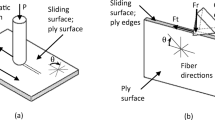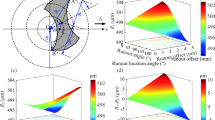Abstract
Among conventional machining operations, milling burr formation has a very complex mechanism. According to the review of literature, exit up milling side burr is the longest and thickest milling burr that needs to be avoided or at least reduced through manipulating effective burr prevention strategies. Knowing that burr thickness B t is the most delicate burr size attribute, a good knowledge on the effects of various cutting parameters (e.g., geometry and coating) as well as friction on the thickness of exit up milling side burr is therefore required to decrease the incidence of burr formation. Although friction angle λ has a direct proportion to negative shear angle ϕ as well as radial and tangential cutting forces (F r, F t), very limited information is still available on relationship between burr thickness B t and friction angle λ in orthogonal milling operations. Therefore, the main aims of this work are then oriented to modeling and experimental characterization of the friction at the exit side of the slot milling operation followed by assessing the relationship between burr thickness B t and friction angle λ at the exit side of slot milled parts of aluminum alloys (AAs). To this end, a computational algorithm was prepared to calculate the instantaneous chip thickness h(φ), tangential and radial cutting forces (F r, F t), friction angle λ, and friction coefficient μ. The experimental results exhibited direct relationships between friction angles, chip load, and burr thickness B t. It was observed that lower friction angle λ is resulted when a larger chip load is applied. Consequently, primary and secondary burr formation is associated with larger and smaller friction angles λ, respectively.
Similar content being viewed by others
References
Niknam SA, Khettabi R, Songmene V. (2014) Machinability and machining of titanium alloys: a review. Machining of titanium alloys: Springer Berlin Heidelberg: p. 1–30.
Niknam SA, Zedan Y, Songmene V 2014 Machining burrs formation & deburring of aluminium alloys. Light metal alloys applications. p. 99–122.
Niknam SA, Songmene V (2015) Milling Burr formation, modeling and control: a review institution of mechanical engineers. Part B: J Eng Manuf 229(6):893–909
Aurich JC, Dornfeld D, Arrazola PJ, Franke V, Leitz L, Min S (2009) Burrs—analysis, control and removal. CIRP Ann Manuf Technol 58(2):519–542
Olvera O, Barrow G (1996) An experimental study of burr formation in square shoulder face milling. Int J Mach Tools Manuf 36(9):1005–1020
Olvera O, Barrow G (1998) Influence of exit angle and tool nose geometry on burr formation in face milling operations. Proc Inst Mech Eng B J Eng Manuf 212(1):59–72
Tsann-Rong L (2000) Experimental study of burr formation and tool chipping in the face milling of stainless steel. J Mater Process Technol 108(1):12–20
Avila MC, Dornfeld DA editors (2004). On the face milling burr formation mechanisms and minimization strategies at high tool engagement. Proceeding of Intl Conf on Deburring and Edge Finishing, UC Berkeley
Korkut I, Donertas M (2007) The influence of feed rate and cutting speed on the cutting forces, surface roughness and tool-chip contact length during face milling. Mater Des 28(1):308–312
Kitajima K, Miyake T, Yamamoto A, Tanaka Y, Takazawa K (1990) Study on mechanism and similarity of burr formation in face milling and drilling. Technol Rep Kansai Univ 31(1):1–33
Kishimoto W, Miyake T, Yamamoto A, Yamanaka K, Takano K (1981) Study of burr formation in face milling. Conditions for the secondary burr formation. Bull Jpn Soc Precis Eng 15(1):51–52
Chern GL (1993). Analysis of burr formation and breakout in metal cutting: PhD Thesis, University of California at Berkeley, USA
Niknam SA, Songmene V (2013) Simultaneous optimization of burrs size and surface finish when milling 6061-T6 aluminium alloy. Int J Precis Eng Manuf 14(8):1311–1320
Niknam SA, Zedan Y, Songmene V (2012) Burr formation during milling of wrought aluminum alloys. 20th ISME Annual International Conference on Mechanical Engineering; 16–18, Shiraz, Iran.
Niknam SA, Songmene V (2013) Factors governing burr formation during high-speed slot milling of wrought aluminium alloys. Pro Inst Mech Eng, Part B: J Eng Manuf 227(8):1165–1179
Niknam SA, Songmene V editors, Experimental investigation and modeling of milling burrs. ASME 2013 International Manufacturing Science and Engineering Conference collocated with the 41st North American Manufacturing Research Conference; 10–14 June 2013,Madison Wisconsin, USA
Ko S, Dornfeld D (1991) A study on burr formation mechanism. J Eng Mater Technol 113(1):75–87
Narayanaswami R, Dornfeld D (1994) Design and process planning strategies for burr minimization and deburring. Trans North Am Manuf Res Inst SME 1994 22:313–322
Chern GL, Dornfeld DA (1996) Burr/breakout model development and experimental verification. J Eng Mater Technol 118:201–206
Ko SL, Dornfeld DA (1996) Analysis of fracture in burr formation at the exit stage of metal cutting. J Mater Process Technol 58(2–3):189–200
Hashimura M, Hassamontr J, Dornfeld D (1999) Effect of in-plane exit angle and rake angles on burr height and thickness in face milling operation. J Manuf Sci Eng 121(1):13–19
Toropov A, Ko S, Lee J (2006) A new burr formation model for orthogonal cutting of ductile materials. CIRP Ann-Manuf Technol 55(1):55–58
Gillespie L (1976) Burrs produced by end milling. BDX-613-1503, Bendix Corp, Kansas City, MO (USA)
Niknam SA (2013). Burrs understanding, modeling and optimization during slot milling of aluminium alloys Ph.D. Thesis, École de Technologie Superieure, Universite du Quebec
Lekkala R, Bajpai V, Singh RK, Joshi SS (2011) Characterization and modeling of burr formation in micro-end milling. Precis Eng 35(4):625–637
Zhang T, Liu Z, Xu C (2013) Influence of size effect on burr formation in micro cutting. Int J Adv Manuf Technol 68(9–12):1911–1917
Avila MC, Dornfeld DA, editors (2004) On the face milling burr formation mechanisms and minimization strategies at high tool engagement. Intl Conf on Deburring and Edge Finishing; University of California at Berkeley
Zedan Y, Songmene V, Khettabi R, Kouam J, Masounave J, editors (2012). Surface integrity of Al6061-T6 drilled in wet, semi-wet and dry conditions. Proceedings of the 37th International Matador Conference: Springer.
Niknam SA, Songmene V (2015). Burr formation and correlation with cutting force and acoustic emission signals. Proceedings of the Institution of Mechanical Engineers, Part B: Journal of Engineering Manufacture. 0954405415590562
Chen M, Liu G, Shen Z, editors. Study on active process control of burr formation in Al-alloy milling process. Proceeding of the IEEE, International Conference on Automation Science and Engineering; 8–10 Oct. 2006, Shanghai, China
Luo M, Liu G, Chen M (2008) Mechanism of burr formation in slot milling Al-alloy. Int J Mater Prod Technol 31(1):63–71
Kim J, Dornfeld DA (2002) Development of an analytical model for drilling burr formation in ductile materials. J Eng Mater Technol 124(2):192–198
Niknam SA, Kamguem R, Songmene V. Analysys and optimization of exit burr size and surface roughness in milling using desireability function ASME 2012 International Mechanical Engineering Congress & Exposition IMECE2012; 9–15 November 2012; November 9–15, Houston, TX, USA.
Niknam SA, Wygowski W, Balazinski M, Songmene V (2014) Milling burr formation and avoidance. In: Davim JP (ed) Machinability of advanced materials. ISTE Wiley, London, UK, pp. 57–94
Niknam SA, Songmene V (2013) Modeling of burr thickness in milling of ductile materials. Int J Adv Manuf Technol 66(9):2029–2039
Niknam SA, Songmene V (2014) Analytical modelling of slot milling exit burr size. Int J Adv Manuf Tech 73(1–4):421–432
Leopold J, Wohlgemuth R (2010) Modeling and simulation of Burr formation: state-of-the-art and future trends. Burrs-Analysis, Control and Removal 79-86
Altintas Y. (2000) Manufacturing automation: Cambridge Univ. Pr.
San-Juan M, Martín Ó, Santos F (2010) Experimental study of friction from cutting forces in orthogonal milling. Int J Mach Tools Manuf 50(7):591–600
Niknam SA, Kouam J, Songmene V (2016) Experimental investigation on part quality and metallic particle emission when milling 6061-T6 aluminium alloy. Int J Mach Mach Mater 18(1–2):120–137
Songmene V, Kouam J, Zaghbani I, Parson N, Maltais A (2013). Global machinability of Al-Mg-Si extrusions. In: Ahmad Zaki P, editor. Aluminium alloys—new trends in fabrication and applications: InTech.
Jones S, Furness R (1997). An experimental study of burr formation for face milling 356 aluminum. Trans—North Am Manuf Res Inst SME.:183–8
AM De Souza J, Sales W, Ezugwu E, Bonney J, Machado A (2003) Burr formation in face milling of cast iron with different milling cutter systems. Proc Inst Mech Eng B J Eng Manuf 217(11):1589–1596
Niknam SA, Songmene V. Statistical investigation on burrs thickness during milling of 6061-T6 aluminium alloy. CIRP 1st International Conference on Virtual Machining Process Technology; 28 May 1 June 2012, Montreal, QC, Canada.
Author information
Authors and Affiliations
Corresponding author
Rights and permissions
About this article
Cite this article
Niknam, S.A. Modeling and experimental characterization of the friction effects on orthogonal milling exit burrs. Int J Adv Manuf Technol 91, 1079–1089 (2017). https://doi.org/10.1007/s00170-016-9828-1
Received:
Accepted:
Published:
Issue Date:
DOI: https://doi.org/10.1007/s00170-016-9828-1




